Snowy owls were popular even before the Harry Potter series. They hold a unique distinction as one of the few bird species depicted in cave art that dates back 30,000 years. These remarkable Arctic birds have ghostly white feathers and big round bodies well-suited for generating and conserving heat. Their expertise lies in noiseless hunting; displaying remarkable patience as they sometimes wait for hours before gracefully gliding across the open land to secure their meal. Astonishingly swift, these owls can reach speeds of up to 50 mph.
One of the most captivating aspects of these creatures is their migratory behavior. While some undertake lengthy migrations, others remain rooted in the Arctic region. And during irruption events, snowy owls can be found in unexpected locations such as Hawaii. What else should you know about these amazing creatures? Follow along to learn all about snowy owls, including their hunting and dietary preferences.
Exploring the Arctic Habitat of the Snowy Owl
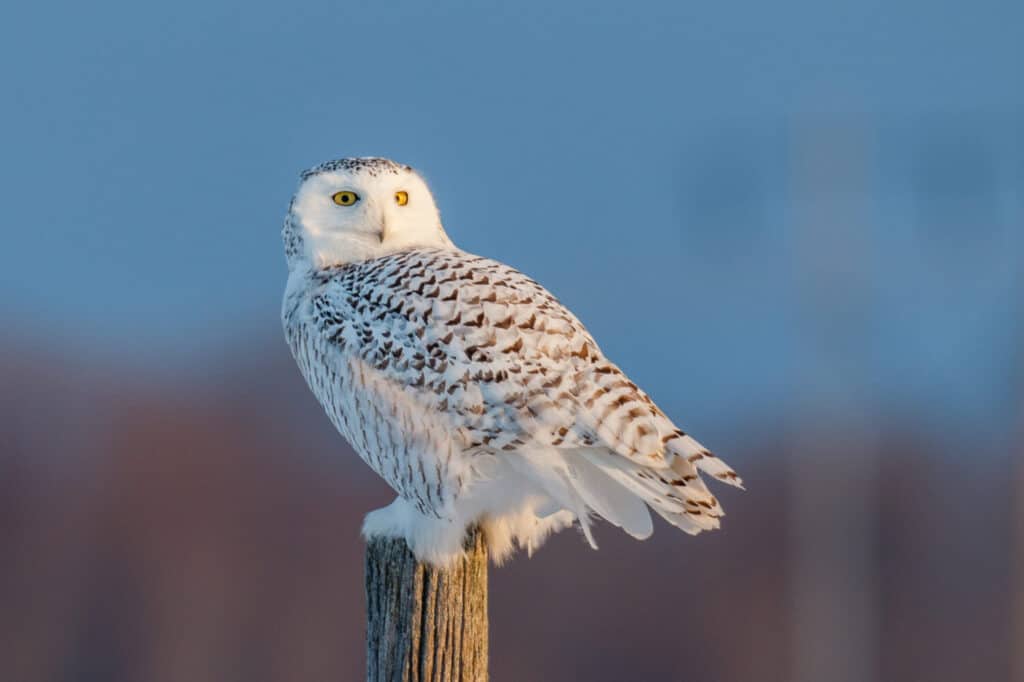
Snowy owls are often seen on a post as they scan the landscape for tasty lemmings.
©Guoqiang Xue/Shutterstock.com
Appropriately named, the snowy owl resides and nests in the northernmost areas surrounding the North Pole. They mainly inhabit the Arctic’s open tundra expanses. Their favorite habitats don’t have a lot of tree cover. Instead, they prefer roaming the Arctic tundra, grasslands, meadows, marshes, and open fields. While here, they spend their time perched on the ground or post, making it easier for them to see their prey. Sitting patiently, they’ll wait for a tasty hare or lemming to cross their path. When flying, they stay close to the ground, showing their love for open spaces.
In non-breeding times, snowy owls are also seen in southern Canada, the northern United States, and parts of Asia and Europe. Snowy owls can also be spotted in New England during the winter months. Sometimes, they go far from their usual range, a behavior called “irruption”. These irruptions lead to surprising sightings even in places like California, Ohio, Texas, and Hawaii.
Where You Can Spot Snowy Owls

Thanks to their unique migratory patterns, snowy owls can be found in the Great Lakes region.
©Christopher Meder/Shutterstock.com
Wide-open spaces like fields and shorelines are prime spots for spotting these lovely birds. Pay close attention to snowy, flat areas that might reveal the outline of an owl concealed within. If they’re not on the ground, they’ll likely be up on a tree stump, fence post, building, or tall pole. When you’re near a beach, keep an eye out for other agitated birds like raptors or gulls, which could indicate the presence of a snowy owl.
The Great Lakes region, including places like Whiskey Island and Lake Erie Bluffs, is particularly favorable for observing snowy owls during winter. Here, they can be found roosting on ice, rocky break walls, or poles, strategically positioning themselves for nighttime hunting and daytime rest. Residents along the shores of Lake Erie in Ohio can spot anywhere from a few to a dozen snowy owls every year. While these owls predominantly prey on lemmings in their Arctic breeding grounds, their diet changes when in the upper Great Lakes region. Here they can be seen feasting on animals like rats, ducks, and fish.
Best Time of Day
Interestingly, snowy owls have a different hunting schedule compared to most owls. While many owls are active at night (nocturnal), snowy owls are more active during the day (diurnal) because of the Arctic summer. They’re especially lively around dawn and dusk. So plan your owl-spotting adventure sometime at the start or end of the day.
Owl Watching Etiquette
Watching a snowy owl can teach you a lot about their behaviors. Plus, they’re a gorgeous large bird that will leave you with a sense of awe. Just make sure you’re doing your part to be owl-smart so that the encounter is both safe and fun.
First, don’t try to feed them. Getting food from humans can make owls too comfortable around people, which is risky for them. You should also avoid flash photography or playing bird calls from your phone. This will only disturb them. Also, whether you’re walking or driving, remember to stay far away from snowy owls. Give them lots of room so you don’t bother or upset them.
Examining the Unique Features of the Snowy Owl
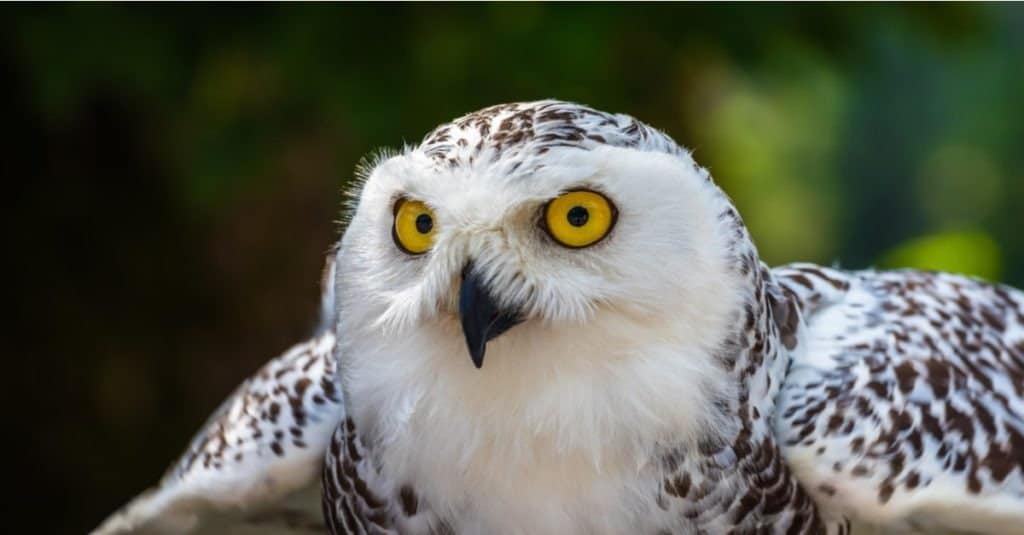
Snowy owls have vivid yellow eyes and dark black beaks, and females have more patterning than males.
©Kayo/Shutterstock.com
Snowy owls are famous for their large size. They have an average length of about 20 to 28 inches, a wingspan ranging from 4.2 to 4.8 feet, and they typically weigh between 3.5 to 6.6 pounds. They also have striking yellow eyes and a dark black beak contrasting their snowy white feathers. Unlike some other owls, snowy owls lack the typical ear tufts.
Snowy white to blend in with their Arctic habitat, the feathers on snowy owls also display intricate patterns like dots and lines. Their feet and claws, also covered with feathers, are mainly white with subtle brown spots. Overall, female snowy owls tend to have denser markings, giving them a salt-and-pepper look, while males look paler and become even whiter with age. As for their tails, males average about three tail bands, while females typically have four to six tail bands. Young owls, especially males, start with significant dark spotting and become whiter as they grow. Their coloration changes seasonally, appearing whiter in summer and transitioning to brown with dark stripes in winter.
Unique Adaptations for Arctic Habitat

Soft feathers enable snowy owls to fly silently as they sneak up on their prey.
©iStock.com/Pasforward
Snowy owls are large for a reason. Like other polar animals, their large size helps them generate and retain more heat. Their lower surface area to volume ratio keeps them nice and warm even in freezing temperatures.
Let’s look at a few more of the snowy owl’s adaptations:
- Large size
- Camouflaged feathers
- Powerful talons
- Circular head movement
- Silent flight
- Round insulated bodies
- Soft feathers
- Feathered legs and feet
- Sharp senses
White Plummage
One of the most striking features of snowy owls is their white, well-covered feathers. Unlike other owls, these feathers extend over their entire body, including their face and legs. This adaptation helps them blend seamlessly into the Arctic landscapes, making them less visible to both prey and predators.
Powerful Talons
Snowy owls have long and strong talons that serve various purposes. They use these talons to catch prey while hunting, which includes small mammals like lemmings and voles, and even slippery fish near water surfaces. Additionally, these talons provide defense against predators and are used during displays of strength.
Exceptional Head Movement
Snowy owls have an amazing ability to turn their heads up to 270 degrees, thanks to their unique neck bone structure, flexible neck muscles, and special arrangement of jugular veins. This allows them to spot prey or predators without needing to move their entire bodies.
Silent Flight
Snowy owls are masters of silent flight, which gives them two major advantages. First, they can approach their prey without alerting them to their presence. Second, they can hear their prey’s movements while closing in. The serrations on the leading edge of their wings and soft feathers work together to reduce noise during flight.
Sharp Senses
Snowy owls possess exceptional hearing and keen eyesight, which are essential for detecting and locating prey in their snowy surroundings. These senses enable them to pinpoint their targets even from a distance. Their remarkable eyesight can be attributed to several factors, one of which is the large size of their eyes, which constitute roughly 5% of their body weight. Unlike round human eyes, snowy owl eyes are elongated with a shape reminiscent of a mushroom. This unique structure allows them to regulate the amount of light entering the eye, granting them the ability to intensely focus on objects.
Understanding the Hunting Techniques and Prey of the Snowy Owl

Snowy owls are very patient hunters, sometimes sitting in the snow for hours as they search for prey,
©Ondrej Prosicky/Shutterstock.com
Snowy owls understand true patience. When hunting, they employ a “sit and wait” technique, a strategy that looks just like it sounds. They find a vantage point, often on a perch or elevated area, and then they sit there, sometimes waiting hours for a meal to cross their path. One of their favorite places to sit and wait is the ground.
Hunting Techniques
Snowy owls can see nearly a mile away, but it’s not always their eyesight that makes them successful. They also have incredible hearing. When they can’t see their prey, they listen for them. Snowy owl ears are positioned asymmetrically on their heads, aiding them in pinpointing the direction of sounds. They can even hear prey moving beneath the snow. When it’s time to strike, their soft feathers help dampen the sound of their approach, making them silent hunters. Flying low over the flat Arctic tundra, they swoop down to catch their unsuspecting prey.
What Snowy Owls Eat

Lemmings, one of the snowy owls’ favorite prey items, are small enough for these owls to swallow whole.
©Angelica Klingberg/Shutterstock.com
A typical daily meal plan for a snowy owl usually involves consuming 3-5 lemmings. However, sometimes they eat a lot more with reports showing can consume as many as 1,600 lemmings in a single summer. During nesting, snowy owls may switch from primarily hunting lemmings to consuming foxes and young ptarmigan also known as snow chickens, as they become available. If food sources are scarce these intelligent birds will begin raiding trap lines, looking for rats near grain elevators, or even searching garbage dumps. This dietary flexibility allows them to adapt to changing conditions and ensure the survival of their young.
How They Eat
Snowy owls are fast eaters. After capturing small prey, they’ll swallow their meal whole. Indigestible parts like bones, teeth, fur, and feathers are formed into oval pellets that the owl regurgitates at roosting sites. Larger prey are carried away and torn into smaller chunks for consumption. When capturing snow-shoe hares, they sink their talons into the prey. Once the hare is exhausted, they use their strong beak to break the hare’s neck before tearing the remains apart.
Investigating the Remarkable Migration Patterns of Snowy Owls
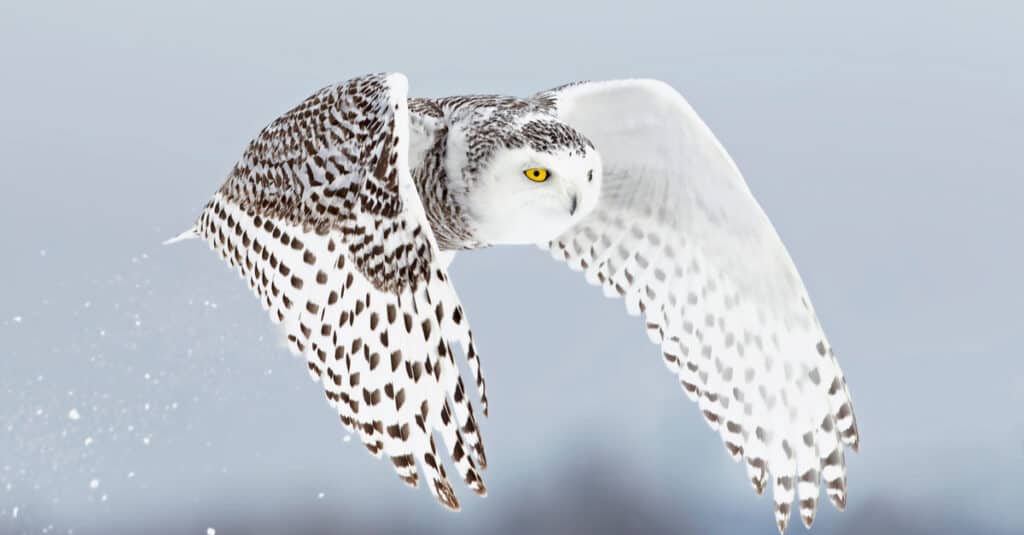
If a snowy owl migrates they usually go to southern Canada and the northern half of the United States.
©Jim Cumming/Shutterstock.com
Snowy owls typically start their journey to wintering sites in late October, with the more common time being mid-November. By early April, most of them have begun their migration back to their breeding grounds in the Arctic Circle. However, there have been some rare cases of individuals lingering at their wintering sites until as late as July.
The duration of their migration journey varies depending on how far they need to travel. They can cover hundreds of miles in just a few days, but they don’t fly nonstop. Instead, they take breaks at stopover sites along the way. They break their journey into shorter stages, resting for days or even weeks before continuing their flight.
Not All Snowy Owls Migrate
Now, not all snowy owls are migratory, and even those that do migrate might not do so every year. Their migration behavior depends on something very important: their food sources. If these prey animals are scarce in the Arctic during the winter, snowy owls might migrate to find better feeding conditions. But it’s not all about food. Migratory choices are impacted by other things like past breeding success.
Where Do They Go?
If they choose to leave, they usually migrate to southern Canada and the northern half of the United States. They’re a common sight in winter in places like the northern plains. They prefer open fields and tundra-like regions in places like New York, New England, and the Midwest. However, their migration patterns aren’t always predictable.
Sometimes, they have what we call “irruption events,” where larger numbers of snowy owls than usual move to regions much farther south than their usual habitat. This can happen in places like the Pacific Northwest, Midwest, and eastern Canada. They can even be spotted wintering across northern continental Europe, central Russia, Iceland, and the British Isles.
More About Snowy Owl Irruptions
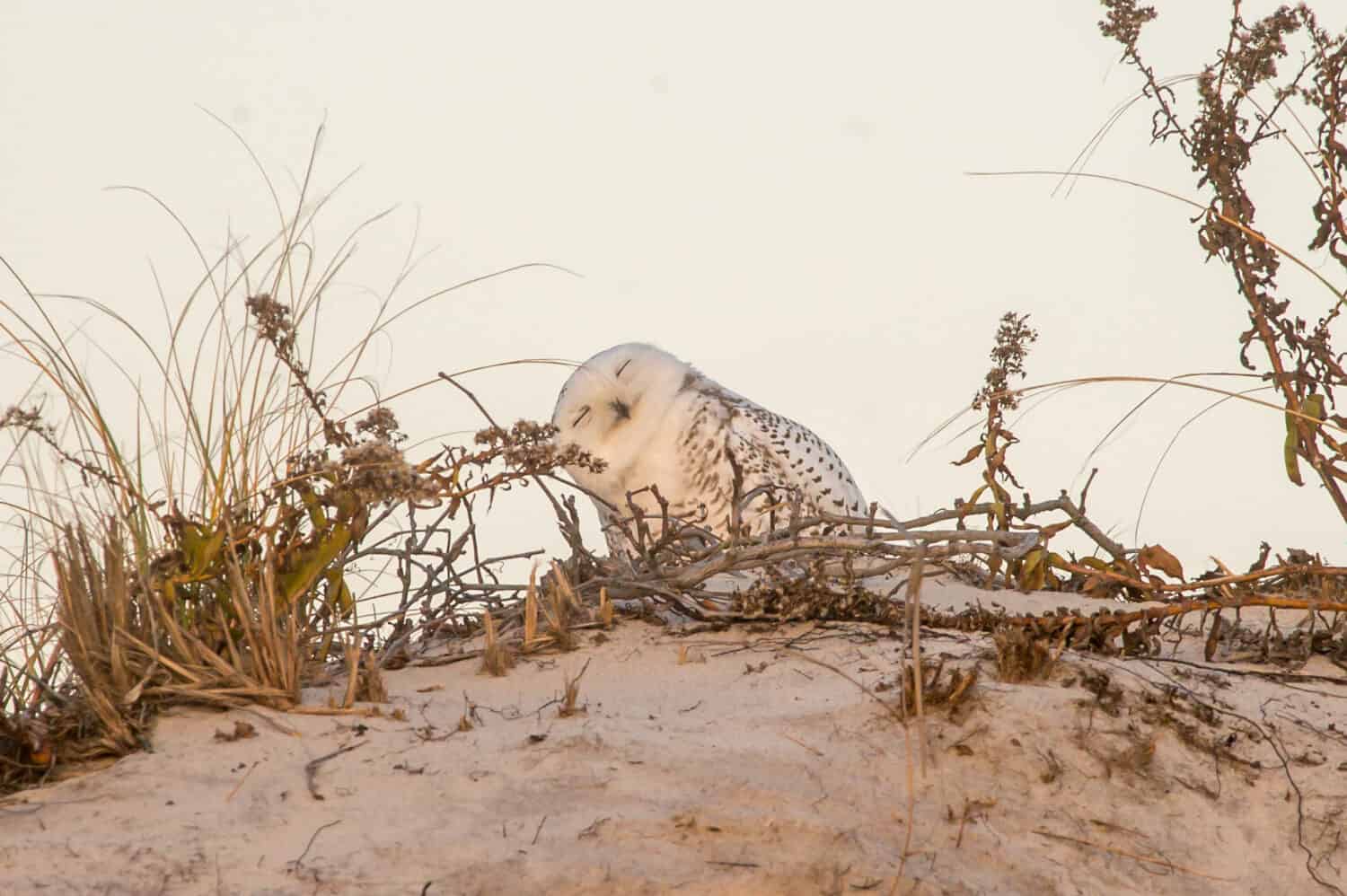
During irruptions, snowy owls can wind up as far south as Florida and even Bermuda.
©Susan L. Angstadt/Shutterstock.com
The snowy owl’s irruptions have fascinated scientists and bird enthusiasts for years. Irruptions are when snowy owls undertake massive southward migrations. Smaller irruptions happen every four to five years, while rare large-scale irruptions only happen once or twice in a person’s lifetime. During mega-irruptions, more owls travel farther south in larger numbers. One of the most extraordinary irruptions happened during the winter of 2013-2014, marking the largest in the Northeast and Great Lakes regions in about a century. Snowy owls were spotted as far south as Florida and even Bermuda.
What Causes Irruptions?
The common belief that snowy owl irruptions are driven solely by hunger and the need for food is a myth. While food availability does play a role, it’s not the only factor that triggers these movements. Instead, irruptions are influenced by a combination of factors. These factors include not only food availability (such as lemming populations, a primary prey for snowy owls) but also various environmental conditions.
Weather conditions play a significant role in snowy owl irruptions. Changes in Arctic weather patterns can affect food availability and influence the movement of these owls to more temperate regions. The number of owl hatchlings in a particular breeding season can also impact irruptions. Successful breeding seasons can lead to higher numbers of young owls that then venture southward. For example, in 2013, there were lots of food in northern Quebec, which helped snowy owls have a successful breeding season. Similarly, years when breeding went well, like 2014 and 2017, were followed by more snowy owl movements to other areas.
Another myth is that snowy owls who travel southward are starving, but the opposite is true. Snowy owls that participate in irruptions are generally healthy, well-fed, and not starving. In fact, they often appear fatter and heavier during major irruption years.
The Importance of Conservation Efforts for Snowy Owl Populations
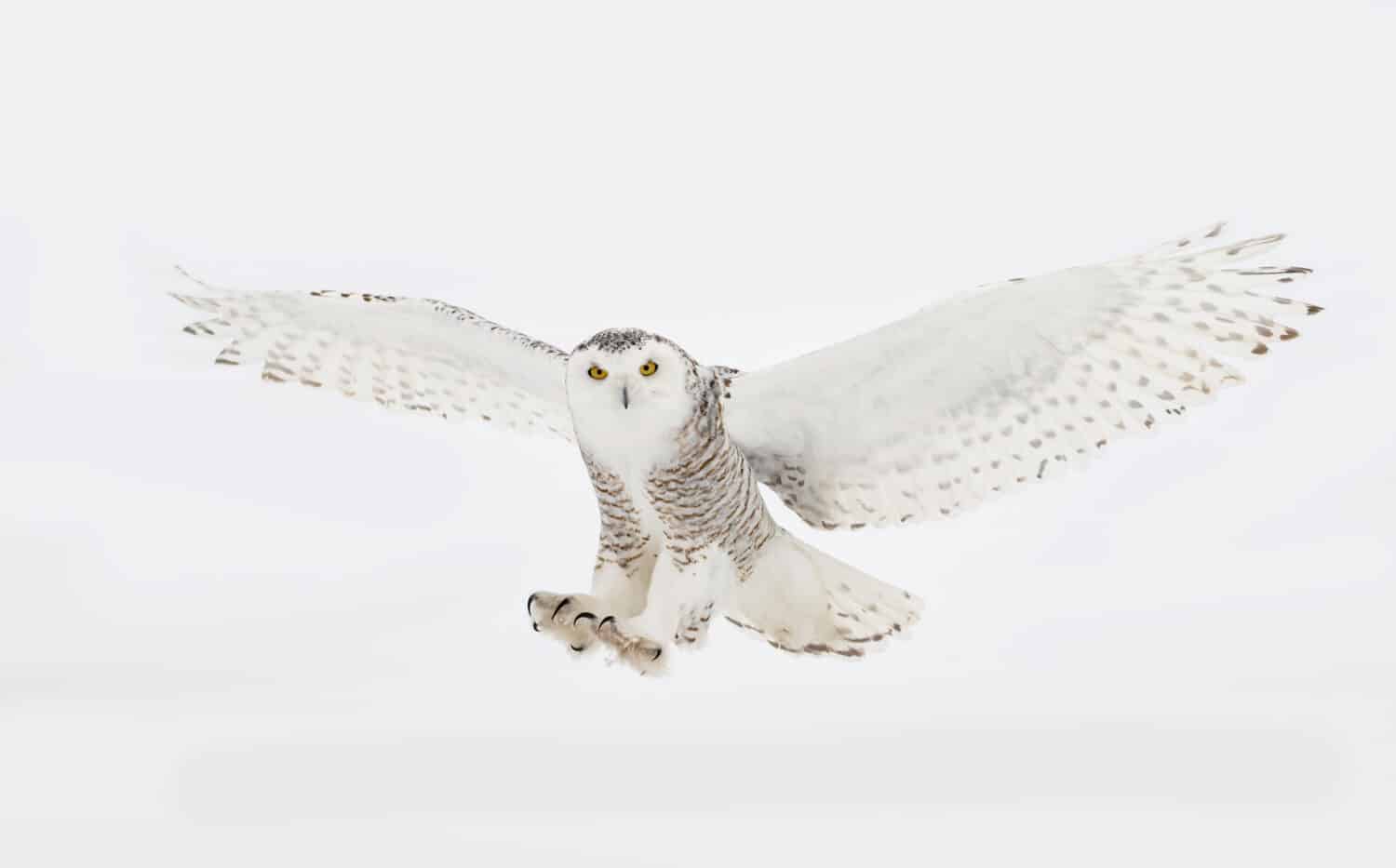
Snowy owls are considered a vulnerable species, and their numbers are likely declining.
©Jim Cumming/Shutterstock.com
While starvation is rare among irrupting snowy owls, they still have quite a few challenges to deal with. Unfortunately, this iconic species is currently facing conservation concerns. Snowy owls are listed as a “Vulnerable” species on the International Union for Conservation of Nature (IUCN) Red List, and their numbers are on the decline. Or at least it appears they are. Accurately estimating snowy owl populations is difficult due to their remote range and natural population fluctuations.
Snowy Owl Conservation Challenges
There are several challenges these birds are facing, such as climate change. Snowy owls rely on a delicate balance of prey availability, nesting sites, and suitable weather conditions. Changes in lemming populations, their primary food source, are driven by climate-related factors. Warming temperatures change the distribution of lemmings, affecting the entire Arctic food web, and thus impacting snowy owls.
Another issue is the loss of habitat. The rapidly changing Arctic landscape due to climate change is disrupting snowy owl habitats. As ice caps melt and ecosystems transform, the resources they rely on are disappearing. This affects their access to nesting sites and prey.
Finally, snowy owls also face threats from human activities. Collisions with vehicles and infrastructure, like power lines, pose dangers. Accidents, poisoning, and electrocution from power lines are some of the risks snowy owls can face during their migration.
How Can You Help Save Snowy Owls?
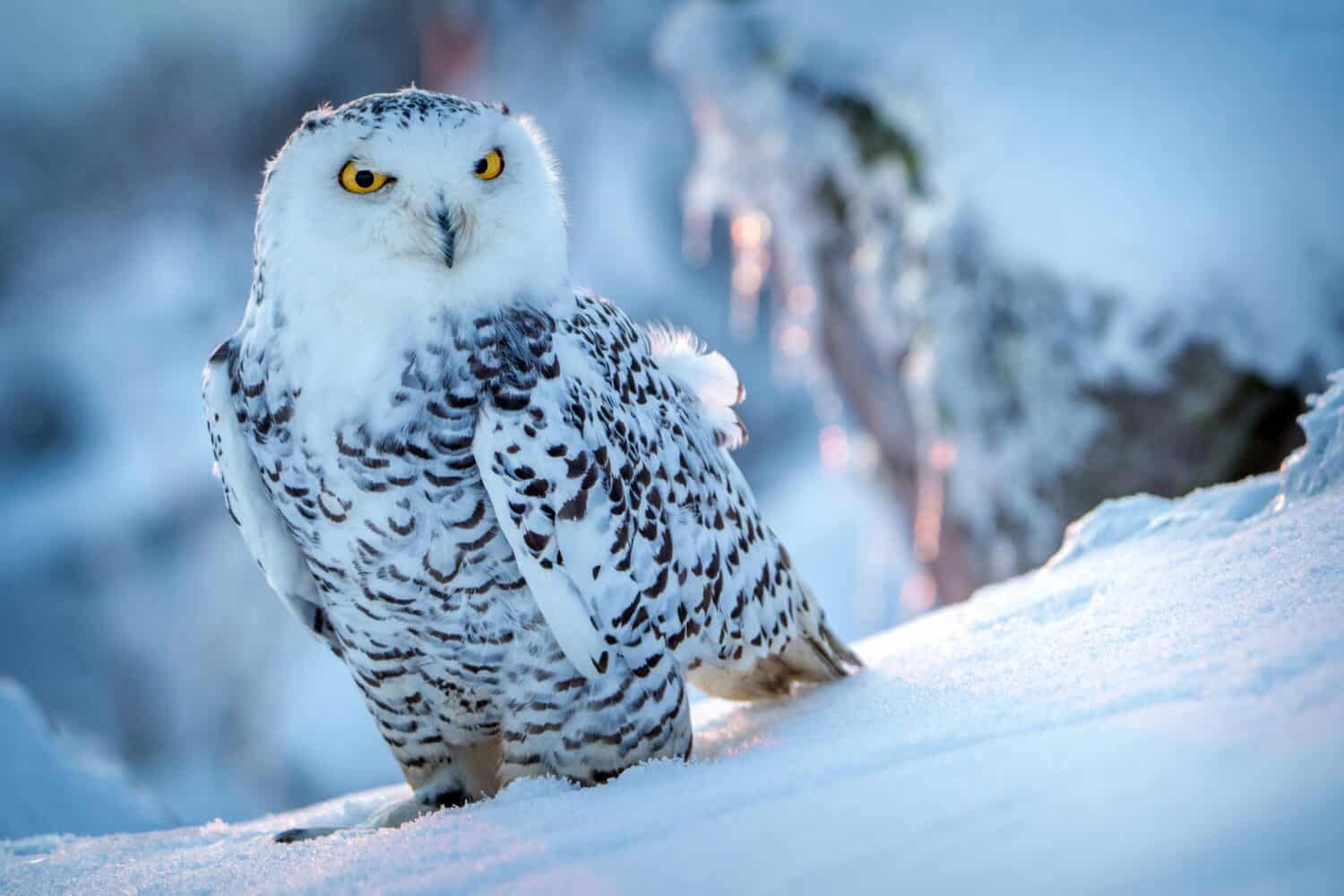
You can help save snowy owls by getting involved with conservation projects like Project SNOWstorm.
©jurra8/Shutterstock.com
What can you do to help save these amazing birds? Start looking for groups who are already working hard to save the snowy owl, like Project SNOWstorm. Donating your time or money to organizations focused on owl conservation provides resources for research, protection, and education. Project SNOWstorm uses advanced science to study snowy owls and gets the public involved in protecting them by spreading the word and educating people.
You can also find ways to spread awareness using your own platforms. Using social media and word-of-mouth to raise awareness can inspire more people to take action. Be a good role model, and practice proper wildlife viewing etiquette, such as giving owls plenty of space and avoiding feeding them. Finally instead of using rodenticides that can poison the owls, opt for traps instead.
Final Thoughts About Snowy Owls
Now you know a lot more about the incredible snowy owl. These large birds are stealthy hunters with a big appetite for lemmings, hares, fish, and more. Sitting on the ground, or perched up high, they scan the landscape before silently swooping down to catch their prey. These owls’ daytime hunting strategy and ability to blend seamlessly into their surroundings are amazing. However, it’s their nomadic tendencies that captivate most birders. They’re snowy owls, but that doesn’t mean they won’t migrate southward, sometimes even winding up in Bermuda. Their epic migrations driven by complex factors leave people guessing where they’ll winter next. If you ever get a chance to see a snowy owl in the wild, it’ll be an experience you’ll never forget.
The photo featured at the top of this post is © Jim Cumming/Shutterstock.com
Thank you for reading! Have some feedback for us? Contact the AZ Animals editorial team.






